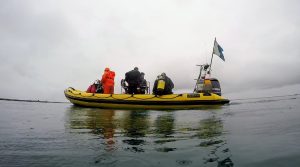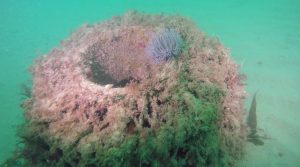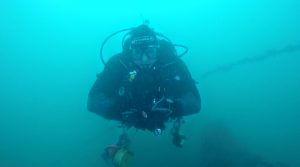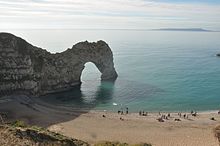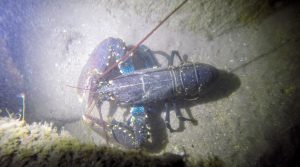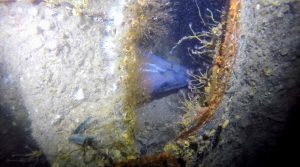By Matt Brown
Over the Easter weekend, a group of intrepid Clidivers descended onto the isle of Portland for the traditional ‘the diving season must begin at Easter’ trip.
It’s always seemed a bit odd that the season begins on a date which itself can vary in the calendar over 35 days, and the early date this year led to diving in what were definitely still winter conditions. But some good company, easy diving and hearty food kept us all happy through the long weekend.
Portland is ideal for an early season trip. It has the full gamut from shallow reefs to deep wrecks, offering something for everyone. Plus the natural harbour means that dives are almost guaranteed, even in the worst weather.
Day 1
While most of us got the train down after work on Thursday, the advanced party had towed and launched the boat during the day. This meant an easier pace for the first day’s diving and no silly o’clock alarms.
The Dredger
Our first dive was on the wreck of an unknown dredger, a favourite for first-time Ocean Divers, and therefore ideal for a refresher dive after the winter break.
The wreck sits at the bottom of the outside of the harbour wall and is in two sections about 50 metres apart. There wasn’t overly much life, but there were some snakelock anemones amongst the wreckage and one buddy pair allegedly saw a cuttlefish (yet failed to provide photographic evidence).
The water temperature was a cool 7 degrees, so most pairs limited themselves to around 35 minutes.
Countess of Erne
The afternoon outing was back within the breakwater for a dive on the Countess. Unlike the Dredger, the fully history of this wreck is known. The Countess was originally a paddle steamer, before being converted into a coal hulk. She sank in 1935 after breaking free of her moorings and hitting the outer harbour wall.
Fortunately for us, this left a fully ship-shaped wreck in shallow water. Its position in the harbour does mean the wreck is very silty and care has to be taken with buoyancy – an ideal thing to practice on a refresher trip.
All buddy pairs came up talking about the surprising vis, with one member saying it’s the first time they’ve actually been able to recognise the site as a ship.
Day 2
Durdle Door
On the Saturday, we headed for the reef just out from the iconic Durdle Door, a natural limestone arch and popular tourist spot on the Jurassic Coast. We thought the wintery weather would put off any tourists, but by the time we surfaced, busfuls had turned up and were wandering around the beach.
The vis here wasn’t great, with the surge in the exposed location churning up the silt. However, the rocky reef was nice enough, with all pairs poking into cracks and generally pootling around. Spider crabs, bib and a range of anemones were reported, so this is definitely a site to keep on the list and maybe revisit in slightly nicer conditions.
Balaclava Bay Drift
Tide times weren’t great for us in the afternoon, so we decided to do a drift dive in Bally Bay, just south of Portland harbour. The dive was a slow drift over a flat reef, so allowed pairs to practise using an SMB during the dive – another skill off the refresh list.
The life was out in force on this dive, with hermit crabs, velvet swimming crabs, edible crabs, wrasse and bib all reported. Word had obviouly spread, as the local dive shop also showed up to drop divers in.
Day 2 was rounded off with another hallowed diving tradition – a curry at the only curry house on Portland (and within walking distance from our hotel).
Day 3
Alex Van Opstal
Feeling sufficiently dived-up after the first two days, and with a favourable weather window before the winds flipped round, we opted for something a bit more adventurous. Sitting in 30m, the Alex Van Opstal was a Belgian passenger liner and one of the very first victims of WW2.
The wreck can only be dived at slack water. We arrived slightly early, set up the shot and dropped it bang on the mark…where it promptly disappeared. Then we waited…and waited. Doubts were beginning to be expressed over knot integrity when suddenly, after 45 minutes, the shot re-emerged (and an update to the club’s slack time database was noted).
Still unsure of the exact slack time, the descent down the shot was hand-over-hand hard work and only one buddy pair made it to the wreck. But what a dive was at the end of that rope! The wreck was encrusted with hundreds of small anemones and, in 30 minutes, we saw two conger eels, a spider crab, a tompot blenny and a large lobster wandering around out in the open (it had obviously forgotten the danger of this activity around divers after its winter break).
Landing Craft & Bombardon Unit
As the weather was turning, the final dive of the trip was back inside the harbour at a triple wreck site. Near the wall is the wreck of a Landing Craft and attached to it via a long rope is a second site with a Bombardon Unit and Vic Lighter. When we checked with the local dive centre if the rope was still there, we got the response “it was last time we checked, 5 months ago” – another joy of early season diving.
The most interesting piece is definitely the Bombardon Unit, a large X-shaped cross-section used as a floating pontoon and wave breaker for the D-Day landings. The silt inside the harbour can make working out the layout of ordinary ships difficult, let alone oddly shaped wreckage, but the site provides some interesting areas to poke around in and to try and work out exactly what you are looking at.
As the weather had turned against us, diving was cancelled on the Monday and the opportunity was therefore taken for a few ‘light refreshments’ on Sunday night.
Overall, it was a good early season trip and allowed a number of members to refresh their skills which can get a bit rusty over the winter break. A few mistakes over the weekend emphasised the need for easy diving like this at the start of the season. Now that we are all dived up – on to rest of the season!
I have posted some videos of the dives:
The Dredger: youtu.be/CvypRAB7aHU
Balaclava Bay: youtu.be/UEa7vz-XV_Y
Alex Van Opstal: youtu.be/LVmz7vKrRmM

